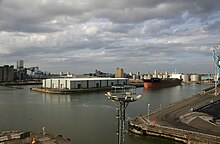
The Bridgwater and Taunton Canal is a canal in the south-west of England between Bridgwater and Taunton, opened in 1827 and linking the River Tone to the River Parrett. There were a number of abortive schemes to link the Bristol Channel to the English Channel by waterway in the 18th and early 19th centuries. These schemes followed the approximate route eventually taken by the Bridgwater and Taunton Canal, but the canal was instead built as part of a plan to link Bristol to Taunton by waterway.

A dry dock is a narrow basin or vessel that can be flooded to allow a load to be floated in, then drained to allow that load to come to rest on a dry platform. Dry docks are used for the construction, maintenance, and repair of ships, boats, and other watercraft.

The word dock in American English refers to one or a group of human-made structures that are involved in the handling of boats or ships. In British English, the term is not used the same way as in American English, it is used to mean the area of water that is next to or around a wharf or quay. The exact meaning varies among different variants of the English language.

Bristol Harbour is the harbour in the city of Bristol, England. The harbour covers an area of 70 acres. It is the former natural tidal river Avon through the city but was made into its current form in 1809 when the tide was prevented from going out permanently. A tidal by-pass was dug for 2 miles through the fields of Bedminster for the river, known as the "River Avon New Cut", "New Cut", or simply "The Cut". It is often called the Floating Harbour as the water level remains constant and it is not affected by the state of the tide on the river in the Avon Gorge, The New Cut or the natural river southeast of Temple Meads to its source.

The Royal Albert Dock is a complex of dock buildings and warehouses in Liverpool, England. Designed by Jesse Hartley and Philip Hardwick, it was opened in 1846, and was the first structure in Britain to be built from cast iron, brick and stone, with no structural wood. As a result, it was the first non-combustible warehouse system in the world. It was known simply as the Albert Dock until 2018, when it was granted a royal charter and had the honorific "Royal" added to its name.
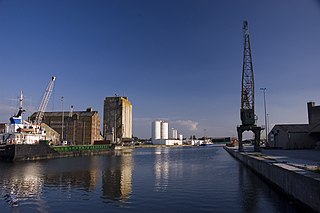
Sharpness is an English port in Gloucestershire, one of the most inland in Britain, and eighth largest in the South West England region. It is on the River Severn at grid reference SO669027, at a point where the tidal range, though less than at Avonmouth downstream, is still large.

Gladstone Dock is a dock on the River Mersey, England, and part of the Port of Liverpool. It is situated in the northern dock system in Bootle. The dock is connected to Seaforth Dock to the north and what remains of Hornby Dock to the south. Part of Liverpool Freeport, Gladstone Dock is operated by the Mersey Docks and Harbour Company.

Huskisson Dock is a dock on the River Mersey, England, which forms part of the Port of Liverpool. It is situated in the northern dock system in Kirkdale. Huskisson Dock consists of a main basin nearest the river wall and two branch docks to the east. It is connected to Canada Dock to the north and Sandon Half Tide Dock to the south.
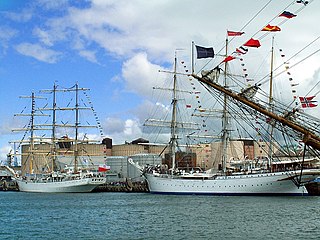
Sandon Half Tide Dock is a half tide dock on the River Mersey, England, and part of the Port of Liverpool. It is situated in the northern dock system in Kirkdale, connected to Huskisson Dock to the north, Wellington Dock to the east and Bramley-Moore Dock to the south. Sandon Dock was situated to the north of Wellington Dock and was accessible via Sandon Half Tide Dock.

The Port of Liverpool is the enclosed 7.5-mile (12.1 km) dock system that runs from Brunswick Dock in Liverpool to Seaforth Dock, Seaforth, on the east side of the River Mersey and the Birkenhead Docks between Birkenhead and Wallasey on the west side of the river. The port was extended in 2016 by the building of an in-river container terminal at Seaforth Dock, named Liverpool2. The terminal can berth two 14,000 container Post-Panamax ships.

Jesse Hartley was Civil Engineer and Superintendent of the Concerns of the Dock Estate in Liverpool, England between 1824 and 1860.
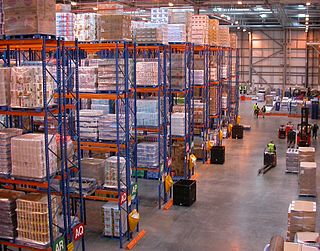
A distribution center for a set of products is a warehouse or other specialized building, often with refrigeration or air conditioning, which is stocked with products (goods) to be redistributed to retailers, to wholesalers, or directly to consumers. A distribution center is a principal part, the order processing element, of the entire order fulfillment process. Distribution centers are usually thought of as being demand driven. A distribution center can also be called a warehouse, a DC, a fulfillment center, a cross-dock facility, a bulk break center, and a package handling center. The name by which the distribution center is known is commonly based on the purpose of the operation. For example, a "retail distribution center" normally distributes goods to retail stores, an "order fulfillment center" commonly distributes goods directly to consumers, and a cross-dock facility stores little or no product but distributes goods to other destinations.
The Port of Bristol comprises the commercial, and former commercial, docks situated in and near the city of Bristol in England. The Port of Bristol Authority was the commercial title of the Bristol City, Avonmouth, Portishead and Royal Portbury Docks when they were operated by Bristol City Council, which ceased trade when the Avonmouth and Royal Portbury Docks were leased to The Bristol Port Company in 1991.

Belfast Harbour is a major maritime hub in Belfast, Northern Ireland, handling 67% of Northern Ireland's seaborne trade and about 25% of the maritime trade of the entire island of Ireland. It is a vital gateway for raw materials, exports and consumer goods, and is also Northern Ireland's leading logistics and distribution hub.
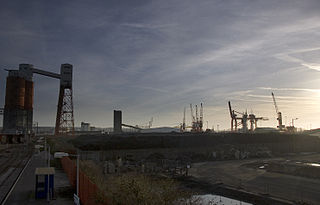
The Avonmouth Docks are part of the Port of Bristol, in England. They are situated on the northern side of the mouth of the River Avon, opposite the Royal Portbury Dock on the southern side, where the river joins the Severn estuary, within Avonmouth.

Port of Kolkata or Kolkata Port, officially known as Syama Prasad Mookerjee Port, is the only riverine major port of India, located in the city of Kolkata, West Bengal, around 203 kilometres (126 mi) from the sea. It is the oldest operating port in India and was constructed by the British East India Company. Kolkata is a freshwater port with no variation in salinity. The port has two distinct dock systems — Kolkata Dock at Kolkata and a deep water dock at Haldia Dock Complex, Haldia.
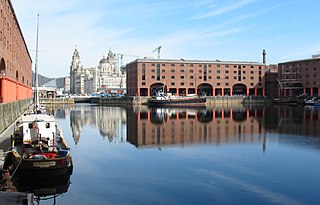
A floating dock, floating harbour or wet dock is a dock alongside a tidal waterway which maintains a 'constant' level, despite the changing tides.

A caisson is a form of lock gate. It consists of a large floating iron or steel box. This can be flooded to seat the caisson in the opening of the dock to close it, or pumped dry to float it and allow it to be towed clear of the dock.
Apapa Port Complex also known as the Lagos Port Complex is Nigeria's largest and busiest port complex. The complex consist of a number of facilities including Apapa quays, Third Apapa Wharf Extension, Apapa Dockyard, Apapa Petroleum Wharf, Bulk Vegetable Oil Wharf, Ijora Wharf, Kirikiri Lighter Terminal, and Lily pond inland container terminal. Financed and built by the colonial government of Nigeria, It became the nation's busiest port for exporting agricultural produce from the provinces of Western and Northern Nigeria in the late 1920s. Administration was transferred to the Nigerian government upon the granting of self-government and In 2005, the complex was divided into terminals and contracted out to private operators with NPA acting as the landlord and regulator.
Preston Dock is a former maritime dock located on the northern bank of the River Ribble approximately 2.5 km (1.6 mi) west of Preston's city centre in Lancashire, England. It is the location of the Albert Edward Basin which opened in 1892 and is connected to the river by a series of locks.
